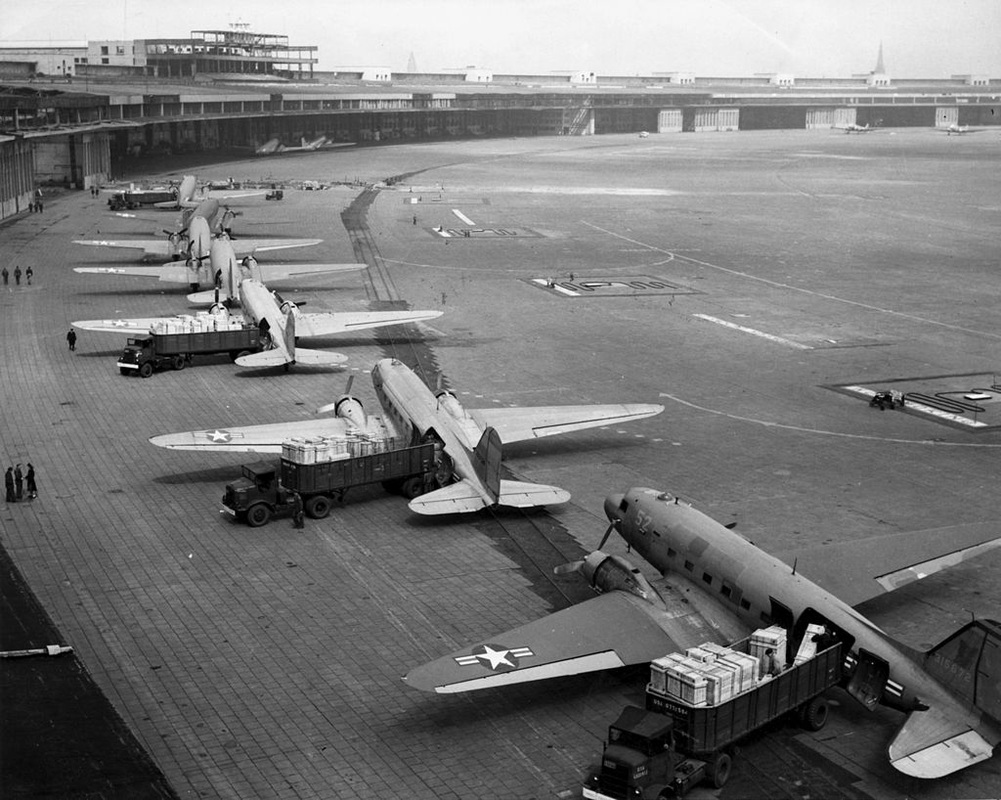Flughafen Berlin-Tempelhof
"The desire to fly is an idea handed down to us by our ancestors who, in their grueling travels
across trackless lands in prehistoric times, looked enviously on the birds soaring freely through space,
at full speed, above all obstacles, on the infinite highway of the air."
(Wilbur Wrigh)
across trackless lands in prehistoric times, looked enviously on the birds soaring freely through space,
at full speed, above all obstacles, on the infinite highway of the air."
(Wilbur Wrigh)
"No flying machine will ever fly from New York to Paris."
(Orville Wright)
(Orville Wright)
Berlins Flughafen Tempelhof, der im am 08. Oktober 1923 feierlich eröffnet wurde, war einst einer der größten Verkehrsflughäfen Deutschlands und einer der drei großen internationalen Verkehrsflughäfen in Berlin (neben Tegel und Schönefeld). Während des Nationalsozialismus sollte er das größte Flugkreuz in Europa werden (die typisch monumentale Bauweise zeugt davon) und wurde dementsprechend ausgebaut.
Zur Zeit des Kalten Krieges spielte er während der Blockade West-Berlins (Sperre sämtlicher Land- und Wasserwege zwischen dem 24. Juni 1948 und 12. Mai 1949 - offiziell endete die gesamte Versorgung durch die Luftbrücke jedoch erst am 30. September '49) durch die Sowjets, welche die Westalliierten mit dem Aufbau einer Luftbrücke zur Aufrechterhaltung der Versorgung der Bevölkerung beantworteten, eine zentrale Rolle.
Der Flughafen selbst verfügt über ein ausgedehntes Keller- und Tunnelsystem. So etwa über einen alten Luftschutzkeller dessen Wände mit Zeichnungen eines unbekannten Künstlers, inspiriert durch jene von Wilhelm Busch, verziert wurden. Vorrangiges Ziel war es, die Nerven der Schutzsuchenden während eines Luftangriffs, welche Berlin zahlreich zu ertragen hatte, zu beruhigen.
Am 30. Oktober 2008 wurde der Flughafen endgültig geschlossen.
Zur Zeit des Kalten Krieges spielte er während der Blockade West-Berlins (Sperre sämtlicher Land- und Wasserwege zwischen dem 24. Juni 1948 und 12. Mai 1949 - offiziell endete die gesamte Versorgung durch die Luftbrücke jedoch erst am 30. September '49) durch die Sowjets, welche die Westalliierten mit dem Aufbau einer Luftbrücke zur Aufrechterhaltung der Versorgung der Bevölkerung beantworteten, eine zentrale Rolle.
Der Flughafen selbst verfügt über ein ausgedehntes Keller- und Tunnelsystem. So etwa über einen alten Luftschutzkeller dessen Wände mit Zeichnungen eines unbekannten Künstlers, inspiriert durch jene von Wilhelm Busch, verziert wurden. Vorrangiges Ziel war es, die Nerven der Schutzsuchenden während eines Luftangriffs, welche Berlin zahlreich zu ertragen hatte, zu beruhigen.
Am 30. Oktober 2008 wurde der Flughafen endgültig geschlossen.
Berlins airport Tempelhof (opened on October 08th, 1923) was one of Germany´s largest commercial airports and one of the three international airports of the city of Berlin among Tegel and Schönefeld. During the Nazi-era it was planned to convert it into the most important airport in Europe and was accordingly expanded (typical Nazi monumental style) by and by.
Tempelhof played a key role In the Cold War era during the "Berlin Blockade" set up by the Soviets which blocked all the roads, railways and canals into Western Berlin in order to avoid access by the Western allies. Consequently, the allies answered the blockade with the so-called "Luftbrücke" (Berlin Airlift) to maintain the supply of the people in West-Berlin.
The underground of the airport holds numerous tunnels, cellars and bunkers. One of them e. g. is a former air-raid shelter with drawings once made by an unknown artist and were inspired by the German poet and painter Wilhelm Busch (known for his children stories of "Max und Moritz").
The airport was closed for good on October 30, 2008.
Tempelhof played a key role In the Cold War era during the "Berlin Blockade" set up by the Soviets which blocked all the roads, railways and canals into Western Berlin in order to avoid access by the Western allies. Consequently, the allies answered the blockade with the so-called "Luftbrücke" (Berlin Airlift) to maintain the supply of the people in West-Berlin.
The underground of the airport holds numerous tunnels, cellars and bunkers. One of them e. g. is a former air-raid shelter with drawings once made by an unknown artist and were inspired by the German poet and painter Wilhelm Busch (known for his children stories of "Max und Moritz").
The airport was closed for good on October 30, 2008.
Der Filmbunker - The film bunker
Eine weitere Besonderheit des Tempelhofer Untergrunds stellt der so genannte Filmbunker dar. Zu Kriegszeiten lagerten dort tonnenweise Filmmaterialien. 1945 verschafften sich die sowjetischen Truppen durch Sprengung der Eingangstür Zutritt zu dem Bunker. Dadurch entzündeten sich allerdings die gelagerten Filme, die, wie damals üblich, aus hochentzündlichem Zelluloid bestanden und der gesamte Inhalt des Filmbunkers wurde vernichtet. Tagelang war an ein Betreten des Bunkers nicht zu denken. Noch heute zeugen die Wände von dem einst wütenden Flammenmeer. Teile der Betonwände wurden durch die Hitze sowie die entstandene Druckwelle sogar stellenweise deformiert.
Another interesting part of the underground world of Tempelhof is the so-called "Filmbunker" which was used as an archive for film materials to protect them during WW II. In 1945 the Soviets used explosives in order to enter the bunker without knowing about the tons of highly flammable films (made of celluloid) stored inside and thus destroyed the whole inventory. As a consequence, they weren´t able to enter the burnt-out bunker for days. Until today the walls blackened by smoke are silent witnesses of the fire once raging through the shelter. Due to the arising heat inside the bunker some of the concrete walls have even been partly deformed.
Satellitenaufnahme - Aerial Image
(©google-earth, 2020)
Alte Ansichten - Old photographs:
Während der Luftbrücke - During the Berlin Blockade:
(©US-Army)
Entladung von Rosinenbombern, 1948 - Unloading airplanes ("candy bombers"), 1948:
(©Georg Wegemann, U.S. Air Force - U.S. Navy National Museum of Naval Aviation photo No. 2000.043.012;
National Museum of the U.S. Air Force photo 050426-F-1234P-008 - gemeinfrei - in the public domain)
National Museum of the U.S. Air Force photo 050426-F-1234P-008 - gemeinfrei - in the public domain)
Luftaufnahme Jahre 1984 - Aerial View 1984:
(©TSGT Jose Lopez Jr., US Air Force - DoD photo, ID DF-ST-85-10904, 1984 - gemeinfrei)


















































